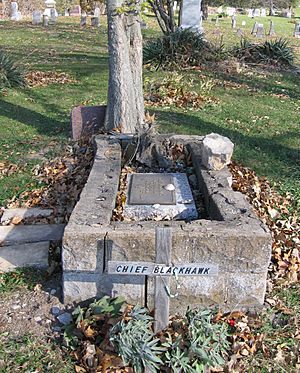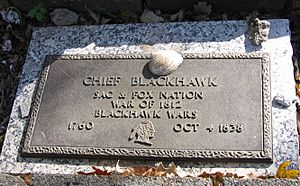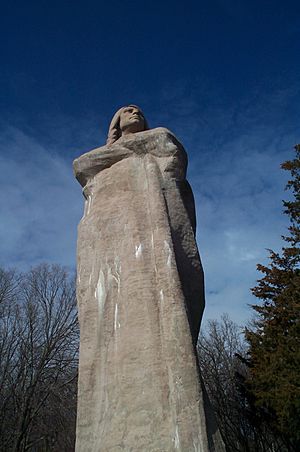Black Hawk (Sauk leader) facts for kids
Quick facts for kids
Black Hawk
|
|
|---|---|
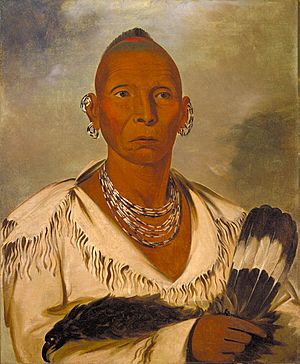
Portrait by George Catlin, 1832
|
|
| Born |
Ma-ka-tai-me-she-kia-kiak
1767 |
| Died | October 3, 1838 (aged 70–71) Davis County, Iowa, U.S.
|
| Monuments | Black Hawk Statue, Black Hawk State Historic Site |
| Nationality | Sauk |
| Other names | Black Sparrow Hawk |
| Occupation | War captain; band leader |
| Known for | Black Hawk War |
Black Hawk, whose original name was Ma-ka-tai-me-she-kia-kiak (Sauk: Mahkatêwe-meshi-kêhkêhkwa), was a respected Sauk leader and warrior. He was born in 1767 and passed away on October 3, 1838. He lived in what is now the Midwestern United States.
Even though he inherited an important sacred bundle from his father, Black Hawk was not a hereditary civil chief. He became a war chief, or captain, because of his brave actions. He led raiding parties when he was young. Later, he led a group of Sauk warriors during the Black Hawk War in 1832.
During the War of 1812, Black Hawk fought alongside the British. He hoped to push white American settlers away from Sauk lands. Later, he led a group of Sauk and Fox warriors, called the British Band. They fought against settlers in Illinois and what is now Wisconsin during the 1832 Black Hawk War. After the war, US forces captured him. He was taken to the Eastern US, where he and other war leaders toured several cities.
Before he was released, Black Hawk shared his story with an interpreter. With help from a newspaper reporter, he published his autobiography in 1833. It was the first book written by a Native American to be published in the US. It quickly became very popular. Black Hawk died in 1838, at about 70 years old, in what is now southeastern Iowa. He is remembered through his book, many places named after him, and other tributes.
Contents
Who Was Black Hawk?
Black Hawk, also known as Black Sparrow Hawk, was born in 1767. His Sauk name, Ma-kat-tai-me-she-kia-kiak, means "be a large black hawk." He was born in the village of Saukenuk on the Rock River. This area is now Rock Island, Illinois. Black Hawk's father, Pyesa, was the tribal medicine man for the Sauk people.
We don't know much about Black Hawk's childhood. It is said he was related to Nanamakee (Thunder), a Sauk chief. This chief supposedly met an early French explorer, possibly Samuel de Champlain. When Black Hawk was about 15, he showed his bravery by wounding an enemy. This earned him a place among the warriors.
Soon after, Black Hawk joined his father, Pyesa, on a raid against the Osage. The young Black Hawk wanted to become a war captain. He led other raids, but with limited success at first. When he was about 19, he led 200 men in a battle against the Osage. In this battle, he personally killed five men and one woman. After this, he joined his father in a raid against the Cherokee near the Meramec River in Missouri. Pyesa was hurt in this battle and later died. Black Hawk then inherited his father's sacred bundle. This gave him an important role in the tribe.
Black Hawk: A War Leader
After a time of mourning for his father, Black Hawk continued to lead raiding parties. He often targeted the Osage, who were a traditional enemy. Black Hawk did not come from a family that provided hereditary civil leaders, or "chiefs," for the Sauk. He gained his status through his success as a warrior. He was known for leading successful raiding parties.
Men like Black Hawk are sometimes called "war chiefs." However, historians like Patrick Jung say it's better to call them "war leaders." This is because their role and power were different from a civil chief. More recently, historians like John W. Hall have used the term "war captain" for this important role.
Fighting in the War of 1812
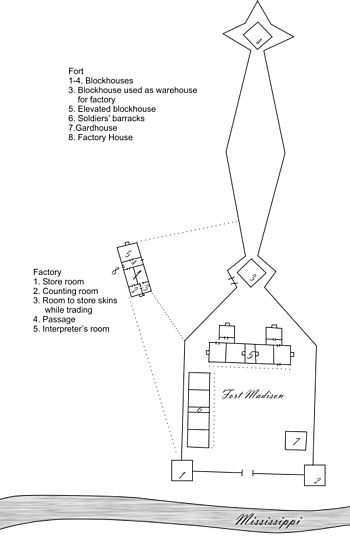
During the War of 1812, Black Hawk was 45 years old. He served as a war leader for a Sauk group at their village of Saukenuk. This group had about 200 warriors. Black Hawk believed that the Treaty of St. Louis (1804) was not valid. This treaty was made between the Sauk and Fox nations and Governor William Henry Harrison. It gave away Sauk land, including Saukenuk, to the United States.
The Sauk and Fox tribes made decisions based on agreement from everyone. The leaders who signed the treaty did not have the power to give away tribal land. Because of this, Black Hawk and other traditional Sauk people did not see the treaty as valid. Black Hawk fought against US forces at the new Fort Madison in the disputed land. This was his first direct fight against the U.S. Army.
In the War of 1812, Great Britain and its colonies fought against the U.S. The British needed help from Native American groups to fight in the Great Lakes area. Robert Dickson, a Scottish fur trader, gathered many Native Americans at Green Bay. They helped the British. Most were from the Potawatomi, Ho-Chunk, Kickapoo, and Ottawa tribes. Black Hawk and his group of about 200 Sauk warriors joined them.
Dickson made Black Hawk a high-ranking officer, a "brevet Brigadier General." He gave Black Hawk command over all Native allies at Green Bay. He also gave him a silk flag, a medal, and a certificate. Black Hawk kept this certificate for 20 years. It was found by US forces after the Battle of Bad Axe.
Black Hawk and Native warriors fought in several battles with Major-General Henry Procter near Lake Erie. Black Hawk was at the Battle of Frenchtown, Fort Meigs, and the attack on Fort Stephenson. The United States Army defeated Tecumseh's Confederacy and killed Tecumseh during the war.
Black Hawk was sad about the many lives lost. He soon left the war to go home. Back in Saukenuk, he found that his rival, Keokuk, had become the tribe's war chief. Black Hawk rejoined the British effort later in the war. He fought with British forces along the Mississippi River near the Illinois Territory. At the Battle of Credit Island and by bothering U.S. troops at Fort Johnson, Black Hawk helped the British push the Americans out of the upper Mississippi River valley.
Black Hawk also fought in the Battle of the Sink Hole in May 1815. He led an ambush against a group of Missouri Rangers. After the War of 1812 ended, Black Hawk signed a peace treaty in May 1816. This treaty confirmed the 1804 treaty. Later, he said he did not know about this part of the agreement.
The Black Hawk War (1832)
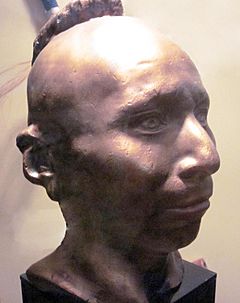
Because of the 1804 treaty, the Sauk and Fox tribes had to give up their lands in Illinois. In 1828, they were moved west of the Mississippi River. Black Hawk and other tribal members disagreed with the treaty. They said their leaders signed it without the full tribe's permission. Black Hawk was angry about losing his birthplace. Between 1830 and 1831, he led his people back into Illinois several times. Each time, he was convinced to return west without fighting.
In April 1832, Black Hawk moved his "British Band" into Illinois. This group had over 1500 people, including warriors and families. He hoped other tribes and Britain would join him. But he found no allies. He tried to return to Iowa, but the Illinois militia started a fight at the Battle of Stillman's Run. Many other violent clashes followed. The governors of Michigan Territory and Illinois gathered their militias to find Black Hawk's Band. These events led to the last Native American War fought east of the Mississippi River. This conflict became known as the Black Hawk War.
When Black Hawk entered Illinois in April, his British Band had about 500 warriors. It also had 1,000 older men, women, and children. The group included members of the Sauk, Fox, and Kickapoo tribes. They crossed the river near the Iowa River and followed the Rock River northeast. They passed the ruins of Saukenuk and went toward the village of the Ho-Chunk prophet White Cloud.
As the war continued, some groups from other tribes joined Black Hawk. Other Native Americans and settlers also committed violence for personal reasons during the chaos. For example, a group of Ho-Chunk who wanted to join Black Hawk attacked and killed Felix St. Vrain's group. This was known as the St. Vrain massacre. This was unusual, as most Ho-Chunk sided with the U.S. during the war. The warriors who attacked St. Vrain's group acted on their own. From April to August, Potawatomi warriors also joined Black Hawk's Band.
The war lasted from April to August 1832. There were many battles, small fights, and massacres on both sides. Black Hawk led his men in another conflict, the Battle of Wisconsin Heights. Afterward, the Illinois and Michigan Territory militias caught up with Black Hawk's "British Band." The final fight was at Bad Axe. At the mouth of the Bad Axe River, soldiers, their Native American allies, and a U.S. gunboat killed hundreds of Sauk and Potawatomi men, women, and children. On August 27, 1832, Black Hawk and Wabokieshiek tried to surrender. They were taken to Zachary Taylor instead. They surrendered to Lieutenant Jefferson Davis, who later became president of the Confederacy.
Touring the East Coast
After the war, most of the British Band was killed or captured. Black Hawk was held at Jefferson Barracks near Saint Louis, Missouri. Other leaders like Neapope and White Cloud were also held there. After eight months, in April 1833, they were taken east. U.S. President Andrew Jackson ordered this. The men traveled by steamboat, carriage, and railroad. Large crowds gathered to see them everywhere they went. Jackson wanted them to see how powerful the United States was. In Washington, D.C., they met with Jackson and Secretary of War Lewis Cass. Then, they were taken to Fortress Monroe in Hampton, Virginia, as prisoners. They stayed there for only a few weeks. During this time, artists painted their portraits.
On June 5, 1833, the men were sent west by steamboat. Their route took them through many large cities. Again, people gathered in huge crowds to see them in cities like Baltimore, Philadelphia, and New York. In the west, closer to the battle sites, the welcome was very different. For example, in Detroit, a crowd burned and hanged effigies (dolls) of the prisoners.
First Native American Autobiography
Near the end of his captivity in 1833, Black Hawk told his life story to Antoine LeClaire. LeClaire was a government interpreter. A local reporter, J.B. Patterson, helped edit the story. Black Hawk's account was one of the first autobiographies by a Native American published in the U.S. The book quickly became a bestseller and has been printed many times.
Some people disagreed about the book. Thomas Ford, the governor of Illinois, did not like Black Hawk, Le Claire, or George Davenport. He thought Black Hawk had little to do with writing his autobiography. He called the book a "catch-penny publication," meaning it was just made to make money.
Black Hawk's Role as a Sauk Leader

Even though he wasn't a hereditary chief, Black Hawk became an important leader for the Sauk people. In 1804, Quashquame gave away much of the Sauk homeland to the United States. This included their main village, Saukenuk. After this, Quashquame was seen as ineffective.
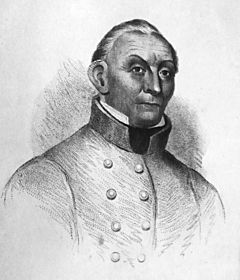
Because of his role in the disputed 1804 treaty, the tribe supported Quashquame less. He became a minor chief. While Black Hawk and Quashquame disagreed, Black Hawk did not directly challenge the civil chief. They seemed to remain on good terms as Black Hawk became more important and Quashquame's influence faded. Quashquame avoided fighting with the U.S., but Black Hawk did not. After Black Hawk tried to take over Fort Madison in 1809, Quashquame worked to fix relations with the US Army the next day.

Before the War of 1812, the U.S. saw Quashquame as loyal or neutral. They knew Black Hawk led the Sauk warriors who sided with the British. Quashquame led all the Sauk non-fighters during the war, and they moved to Saint Louis.
After the war, a disagreement grew among the Sauk. In 1815, Quashquame was part of a group that signed a treaty. This treaty confirmed a split between the Sauk along the Missouri River and the Sauk who lived along the Rock River at Saukenuk. The Rock River group was known as the British Band. Their warriors were the main fighters in the Black Hawk War. Around 1824, Quashquame sold a large Sauk village in Illinois to a trader named Captain James White. White gave Quashquame "a little 'sku-ti-apo' [liquor] and two thousand bushels of corn" for the land. This land later became Nauvoo, Illinois. This sale likely angered Black Hawk and other Sauk who wanted to keep their claim on Illinois.
As Quashquame's son-in-law, Taimah, became the Sauk chief favored by the U.S., Quashquame's willingness to compromise lost standing compared to Black Hawk's resistance. When Caleb Atwater visited Quashquame in 1829, he described him as weak. He seemed more interested in art and relaxation than politics. But he still preferred talking things out over fighting. In the summer of 1830, Black Hawk began moving into the disputed Illinois territory. This eventually led to the Black Hawk War.
Black Hawk's frequent rival was Keokuk. Keokuk was a Sauk war chief highly respected by the U.S. government. Officials thought he was calm and willing to negotiate, unlike Black Hawk. Black Hawk disliked Keokuk. He saw him as cowardly and selfish. At one point, Black Hawk even threatened to kill Keokuk for not defending Saukenuk. After the Black Hawk War, U.S. officials named Keokuk the main Sauk leader and would only deal with him.
Black Hawk's Final Days
After his tour of the east, Black Hawk lived with the Sauk people. They lived along the Iowa River and later the Des Moines River near Iowaville in what is now southeast Iowa. Toward the end of his life, he tried to make peace with both American settlers and his Sauk rivals, including Keokuk. He spent some time in Burlington, Iowa at the home of a businessman named Jeremiah Smith, Jr.. An attorney who shared a room with him remembered, "I roomed with Black Hawk for weeks, and observed him carefully and under all circumstances. He was uniformly kind and polite, especially at the table; but often silent, abstracted and melancholy.... He presented the noble spectacle of a warrior chief, conquered and disgraced with his tribe by his conquerors; but, resigned to his fate and covered with the scars of many battles, in the spirit of true heroism, breaking bread with and enjoying the hospitality of his destroyers."
Black Hawk died on October 3, 1838, after being sick for two weeks. He was buried on the farm of his friend James Jordan. This was on the north bank of the Des Moines River in Davis County.
In July 1839, his remains were stolen by James Turner. Turner prepared his skeleton for display. Black Hawk's sons, Nashashuk and Gamesett, went to Governor Robert Lucas of Iowa Territory. The governor used his power to bring the bones to safety in his offices in Burlington. With his sons' permission, Black Hawk's remains were kept by the Burlington Geological and Historical Society. When the Society's building burned down in 1855, Black Hawk's remains were destroyed.
Another story says that Governor Lucas gave Black Hawk's bones to Enos Lowe, a doctor in Burlington. Lowe supposedly left them to his partner, Dr. McLaurens. After McLaurens moved to California, workers reportedly found the bones at his house. They buried the remains in a common grave in Aspen Grove Cemetery in Burlington.
There is a marker for Black Hawk in the Iowaville Cemetery on the hill above the river. However, it is not known if any of his remains are actually there.
Black Hawk's Family Life
Even though the Sauk people sometimes had more than one wife, Black Hawk had only one wife. Her name was As-she-we-qua, or Singing Bird (her English name was Sarah Baker). She passed away on August 28, 1846. They had five children together. His oldest son and youngest daughter died in the same year, before 1820. Black Hawk mourned their loss for two years, following Sauk tradition. During this time, he lived alone and fasted. His other children were a daughter named Namequa (Running Fawn, also known as Ailey Baker) and two sons, Nasheakusk (also called Nashashuk) and Gamesett (also called Nasomsee).
Black Hawk's Legacy
Through the interpreter Antoine LeClair, Black Hawk told his life story. It was published in 1833 as Life of Ma-ka-tai-me-she-kia-kiak (or Life of Black Hawk).
A sculpture by Lorado Taft stands overlooking the Rock River in Oregon, Illinois. This statue is called The Eternal Indian, but it is commonly known as the Black Hawk Statue. Today, Black Hawk is seen as a tragic hero. Many things are named after him, including roads, sports teams, and schools. Among the many wars in United States history, the Black Hawk War is one of the few named after a person.
There is a popular story that the Olympic gold medal-winning athlete Jim Thorpe was a descendant of Black Hawk.
Leafy Anderson, an African American spiritualist from Wisconsin, claimed that Black Hawk was one of her main spirit guides. Many churches in the Spiritual Church Movement, which she founded, seek his guidance and protection. Special "Black Hawk services" are held to ask for his help. Statues or busts representing him are kept on altars in homes and churches by his followers.
Places and Things Named After Black Hawk
Many places and things are named after Black Hawk. Here are some notable examples:
- Several place names, including Black Hawk County, Iowa, the Black Hawk Bridge between Iowa and Wisconsin, and the historical Black Hawk Purchase in Iowa.
- Four United States Navy ships were named USS Black Hawk.
- The 2nd Squadron of the 1st US Cavalry Regiment (2-1 CAV).
- One Liberty ship built in 1943 was named Black Hawk.
- The Chicago Blackhawks of the National Hockey League are indirectly named after Black Hawk. Their first owner, Frederic McLaughlin, was a commander in a military unit called the "Black Hawk Division" during World War I. McLaughlin named the hockey team to honor his military unit.
- Blackhawk Middle School, in Bensenville, Illinois.
- Black Hawk College, a community college with its main campus in Moline, IL.
- Blackhawk Country Club, a private golf club in Shorewood Hills, Wisconsin.
- The athletic teams of Prairie du Chien High School in Prairie du Chien, Wisconsin are called the Blackhawks.
- The athletic teams of Fort Atkinson High School, Wisconsin are also named "Blackhawks."
- The Atlanta Hawks were first called the Tri-Cities Blackhawks in the first season of the NBA. This was in the Tri-Cities (now Quad Cities) area in Illinois and Iowa. The team was named for the Black Hawk War.
- The Sikorsky UH-60 Black Hawk, a four-blade, twin-engine helicopter used by the US military and many armed forces worldwide.
- The athletic teams of West Aurora High School, Illinois are named the Blackhawks. Their mascot is "Chief Blackhawk."
- Iowa's nickname, the "Hawkeye State," was adopted in 1838 to honor Chief Black Hawk.
- The film "Big Chief, Black Hawk" is named after a Mardi Gras Indian Tribe. This tribe was named "Black Hawk Hunters" by Terrance Williams Jr. to honor Black Hawk.
See also
 In Spanish: Halcón Negro (jefe tribal) para niños
In Spanish: Halcón Negro (jefe tribal) para niños



